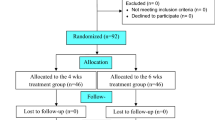Abstract
A comparison was made of the results obtained with ciprofloxacin (750 mg/12 h) and doxycycline (100 mg/12 h), both administered p.o. for one week, in 34 and 36 patients respectively with Mediterranean spotted fever. Apyrexia was achieved after 50.1 ± 34.2 h (mean ± SD) of antibiotic therapy in the group of patients treated with ciprofloxacin and in 55.2 ± 23.3 h in the group treated with doxycycline (no significant statistical differences). Resolution of the remaining signs and symptoms of the disease was achieved faster with ciprofloxacin. Both therapeutic regimens were effective and safe. Although more expensive than doxycycline, ciprofloxacin is a bactericidal compound which is better tolerated and has a lower risk of toxicity and of development of resistance. It can be considered, together with doxycycline, as an antibiotic of first choice in the treatment of Mediterranean spotted fever.
Similar content being viewed by others
References
Bernard JG, Bereni J, Hainaut J: Aspect actuel des rickettsioses en Algérie. Bulletin de la Societé de Pathologie Exotique 1963, 56: 620–628.
Gear JHS, Miller GB, Martin H, Swanpoel R, Wolstenholme B, Coppin A: Tickbite fever in South Africa. The occurrence of severe cases on the Witwatersrand. South African Journal of Medical Sciences 1983, 63: 307–310.
Gutman A, Schreiber H, Toragan R: An outbreak of tick typhus in the coastal plains of Israel. Transactions of the Royal Society of Tropical Medicine and Hygiene 1973, 67: 112–121.
Raoult D, Nicolas N, De Micco P, Gallais H, Casanova P: Aspects épidémiologiques de la fièvre boutonneuse méditerraneéne en Corse du Sud. Bulletin de la Societé de Pathologie Exotique 1985, 78: 446–451.
Weyer F: Progress in ecology and epidemiology of rickettsioses. Acta Tropica 1978, 35: 5–21.
Stille W: Tick-borne spotted fever (“fièvre boutonneuse”) as an imported infection. Deutsche Medizinische Wochenschrift 1971, 96: 116–118.
Anderson JF, Magnarelli LA, Burgdorfer W, Casper EA, Philip RM: Importation into the United States from Africa ofRhipicephalus simus on a boutonneuse fever patient. American Journal of Tropical Medicine and Hygiene 1981, 30: 897–899.
Barret-Connor E, Ginsberg MM: Imported South African tick typus. Western Journal of Medicine 1983, 138: 264–266.
Schaeffer F, Lederer K, Mates SM: Mediterranean spotted fever in an American woman. Archives of Internal Medicine 1985, 145: 1753–1754.
Harris RL, Kaplan SL, Bradshaw MW, William TW: Boutonneuse fever in American travellers. Journal of Infectious Diseases 1986, 153: 126–128.
Raoult D: Antibiotic susceptibility ofRickettsia and treatment of rickettsioses. European Journal of Epidemiology 1989, 5: 432–435.
Muñoz-Espín T, López-Pares P, Espejo-Arenas E, Font Creus B, Martínez-Vila I, Travesía-Casanova J, Segura-Porta F, Bella-Cueto F: Erythromycin versus tetracycline for treatment of Mediterranean spotted fever. Archives of Diseases of Childhood 1986, 61: 1027–1029.
Raoult D, Gallais H, de Micco P, Casanova P: Ciprofloxacin therapy for Mediterranean spotted fever. Antimicrobial Agents and Chemotherapy 1988, 3: 606–607.
Petrosillo M, Anzalone E, Casinelli K, Campoli A, Corbo A, Gallo A, Tersigni I, Maddaluno R: Pefloxacin in the treatment of Boutonneuse fever. In: Kazar J, Raoult D (ed): Rickettsiae and rickettsial diseases. Publishing House of the Slovak Academy of Sciencies, Bratislava, 1991, p. 718–721.
Gudiol F, Pallares R, Carratalá J, Bolao F, Ariza J, Rufi G, Viladrich PF: Randomized double-blind evaluation of ciprofloxacin and doxycycline for Mediterranean spotted fever. Antimicrobial Agents and Chemotherapy 1989, 33: 987–988.
Ruiz Beltrán R, Herrero Herrero JI, Martín Sánchez AM, Vicente García V, Sanz Ortega F, Mateos Sánchez A, Querol Prieto R, Portugal Alvarez J: Formas graves de fiebre exantemática mediterránea. Análisis prospectivo de 71 enfermos. Anales de Medicina Interna 1985, 2: 365–368.
Dermatino G, Narciso P, Struglia C, Zechini F, Visco G: Esperience terapeutiche nella rickettsiosi conorii con monodose di doxiciclina. Clinique Terapeutiche 1981, 97: 59–62.
Bella-Cueto F, Font-Creus B, Segura-Porta F, Espejo-Arenas E, López-Pares P, Muñoz-Espín T: Comparative randomized trial of one-day doxycycline versus 10-day tetracycline therapy for Mediterranean spotted fever. Journal of Infectious Diseases 1987, 155: 1056–1058.
Yagupski P, Gross EM, Alkan M, Bearman JE: Comparison of two dosage schedules of doxycycline in children with rickettsial spotted fever. Journal of Infectious Diseases 1987, 155: 1215–1219.
Huys J, Kayihigi J, Freyeiss P, Berghe GJ: Single-dose treatment of epidemic typhus with doxycycline. Chemotherapy 1973, 18: 314–317.
Krause DW, Perine PL, McDade JE, Awoke S: Treatment of louse-borne typhus with chloramphenicol, tetracycline or doxycycline. East African Medical Journal 1975, 52: 421–427.
Brown GW, Saunders JP, Sadhu S, Huxsoll DL, Shirai A: Single dose doxycycline therapy for scrub thyphus. Transactions of the Royal Society of Tropical Medicine and Hygiene 1987, 72: 412–416.
Hooper DC, Wolfson JS: The fluoroquinolones: pharmacology, clinical uses and toxicities in humans. Antimicrobial Agents and Chemotherapy 1985, 28: 716–721.
Raoult D, Roussellier P, Galicher V, Pérez R, Tamalet J: In vitro susceptibility ofRickettsia conorii to ciprofloxacin as determined by suppressing lethality in chicken and by plaque assay. Antimicrobial Agents and Chemotherapy 1985, 29: 424–425.
McClain JB, Joshi B, Rice R: Chloramphenicol, gentamicin, and ciprofloxacin against murine scrub typhus. Antimicrobial Agents and Chemotherapy 1988, 32: 285–286.
Ruiz Beltrán R, Herrero Herrero JI, Walker DH, Cuñado Rodríguez A: Mechanism of upper gastro-intestinal hemorrhage in Mediterranean spotted fever. Tropical and Geographical Medicine 1990, 42: 78–82.
Smith JT: The mode of action of 4-quinolones and possible mechanisms of resistance. Journal of Antimicrobial Chemotherapy 1985, 18, Supplement D: 21–29.
Author information
Authors and Affiliations
Rights and permissions
About this article
Cite this article
Ruiz Beltrán, R., Herrero Herrero, J.I. Evaluation of ciprofloxacin and doxycycline in the treatment of mediterranean spotted fever. Eur. J. Clin. Microbiol. Infect. Dis. 11, 427–431 (1992). https://doi.org/10.1007/BF01961857
Issue Date:
DOI: https://doi.org/10.1007/BF01961857




